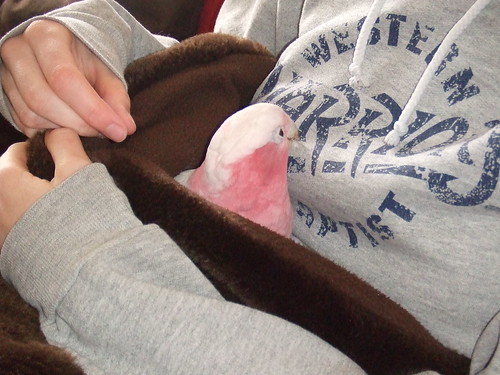
Rosebreasted cockatoo and Jamie's mom
Q: I am at home sick with a cold. Can my bird catch it?
— Justine, V., Fairfax, VA
A: A veterinarian once told me that a client brought her amazon in with a “terrible cold”. It was coughing, sneezing and sniffling with a “runny nose”. The doctor dutifully examined the bird, feeling pretty confident about the outcome.
When he was finished checking the bird, the vet asked her client if she, herself, had recently been sick. She replied that she’d had a cold and that she felt terrible about passing it on to her bird. The doctor explained to her that her bird was perfectly healthy, but had a “sick” sense of humor.
Humans do not transfer cold or flu viruses to their birds. In fact, there a only a couple of uncommon viruses that can be passed along to them, but it is very difficult to do so. We spend much more time in and around their body fluids than they do ours.

Rosebreasted cockatoo
Of bigger concern is transmitting Gram-negative bacteria to our birds through our saliva. In our mouths, in fact in the mouths of all mammals, are bacteria that the avian body does not carry and are unequipped to deal with. We should never let our birds eat from our mouths, share food we have bitten into, or eat from our utensils. When we kiss our birds, we should be very careful not to transfer saliva. (I wouldn’t DREAM of asking you not to kiss your birds!)
Gram-negative bacteria can also be present on the claws of our four-legged pets through their saliva. If your bird is ever bitten OR scratched by another pet it requires immediate veterinary care.
For those of you curious as to what Gram-negative bacteria is…
“Gram staining” is a process your veterinarian uses to separate into two groups the bacterias found in samples taken from your bird: negative and positive. A purple dye is introduced to the sample for staining.
Gram-negative bacteria has a thicker cell wall than Gram-positive bacteria and resists absorbing the colorant used in staining. Gram-negative bacteria, which prefer a wet environment, turns pink in the gram staining process – Gram-positive bacteria, which thrives in a drier place, such as skin, turns purple. Human pathogens are mostly Gram-negative.
A Danish physician, named Hans Christian Joachim Gram, further advanced the technique originally developed by a German biologist and the process used today was named for him.
Author Patty Jourgensen specializes in avian health, behavior and nutrition and has been working with and caring for rescue birds since 1987.


Be the first to comment